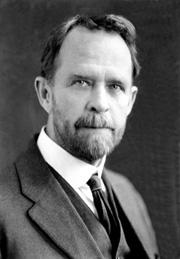Reflections on T.H. Morgan
by John M. Rawls (Morgan School Director, 1989-95)
 Thomas Hunt Morgan (1866-1945) is a truly legendary figure in biology. He was an internationally respected developmental biologist before his famous role in establishing the field of genetics and he was the recipient of numerous awards and honorary degrees, including the Nobel Prize for Medicine or Physiology in 1933. As a Lexington native and recipient of both Bachelor of Science (1886) and Master of Science (1888) degrees from the State College of Kentucky (now U.K.), it was fitting that the School of Biological Sciences was dedicated to the memory of this outstanding scholar.
Thomas Hunt Morgan (1866-1945) is a truly legendary figure in biology. He was an internationally respected developmental biologist before his famous role in establishing the field of genetics and he was the recipient of numerous awards and honorary degrees, including the Nobel Prize for Medicine or Physiology in 1933. As a Lexington native and recipient of both Bachelor of Science (1886) and Master of Science (1888) degrees from the State College of Kentucky (now U.K.), it was fitting that the School of Biological Sciences was dedicated to the memory of this outstanding scholar.
Among his many scientific achievements, Morgan's work with the fruit fly Drosophila melanogaster, is the most widely known. Introduced into his lab at Columbia University in 1908, over the following ten years this species emerged as the premier system for genetic studies through the work of Morgan and the exceptional group of students and associates that he assembled in the famous "fly room", that included Alfred Sturtevant, Calvin Bridge, Curt Stern, Herman Muller (a future Nobel laureate), and a host of others. Beyond his personal discovery of sex-linked inheritance and his prediction that genes were located on chromosomes, he supervised and participated in the discovery of crossing-over and genetic mapping. His contributions as patriarch of that community are very significant. He established ethical standards under which a premium was placed upon the free exchange of ideas and materials, with primary credit for discoveries going to the persons who actually did the experiments. Today, the community of Drosophila scientists is large (over 3,500 attended last year's annual meeting in Atlanta), but it is still distinguished by open communications and professional generosities.
Drosophila is a beautiful animal, and it provides an incredibly productive system for understanding basic process of genetics and development. For example, three Drosophila workers shared the 1995 Nobel Prize for discovering how genes establish the basic body plan in early embryos. Anyone working with fruit flies inherits ideas that stem from Morgan. I joined that community as a graduate student and I have felt a relationship to Morgan throughout my professional life. That relationship can be described as fourth generation: I was a student of a student (John Lucchesi) of a student (Curt Stern) of Morgan's. Despite differences in the underlying mechanisms, there are parallels between the inheritance of ideas and genes. We owe much of our understanding of the latter to Thomas Hunt Morgan.
